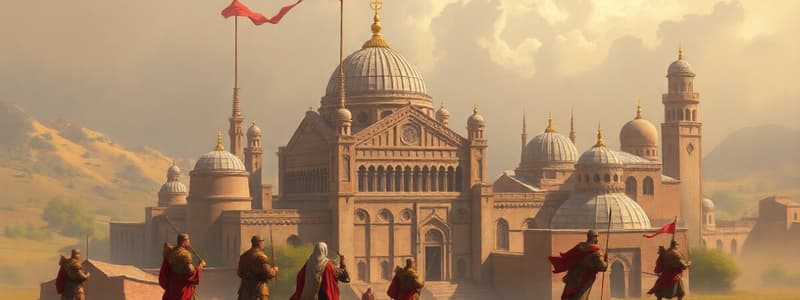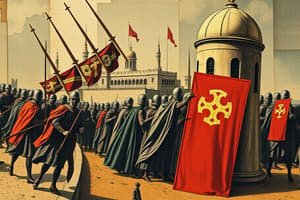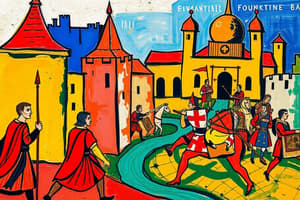Podcast
Questions and Answers
Which of the following factors contributed most significantly to the Byzantine Empire's request for assistance from Western Europe?
Which of the following factors contributed most significantly to the Byzantine Empire's request for assistance from Western Europe?
- Economic hardships within the Byzantine Empire due to trade blockades imposed by Western European nations.
- The expansion of various Islamic powers, particularly the Seljuk Turks, at the expense of Byzantine territory. (correct)
- A desire to reconcile with the Pope after the Great Schism.
- Internal political conflicts that weakened the Byzantine military.
Pope Urban II's call for the First Crusade at the Council of Clermont in 1095 was primarily motivated by:
Pope Urban II's call for the First Crusade at the Council of Clermont in 1095 was primarily motivated by:
- A strategic move to undermine the authority of the Byzantine Emperor and establish papal dominance in the East.
- An attempt to unify the various Christian factions within Western Europe against a common enemy.
- A genuine, religiously driven desire to liberate the Holy Land, coupled with potential political and economic gains. (correct)
- Pressure from secular rulers in Western Europe who sought territorial expansion in the Middle East but required religious justification.
The First Crusade, which took place between 1096 and 1099, had the primary goal of:
The First Crusade, which took place between 1096 and 1099, had the primary goal of:
- Defending the Byzantine Empire from Viking invasions.
- Establishing new trade routes between Europe and Asia.
- Converting the Slavic tribes to Christianity.
- Reconquering lands acquired by Muslims, with a focus on Jerusalem. (correct)
What request did Byzantine Emperor Alexios I Komnenos make that ultimately led to the First Crusade?
What request did Byzantine Emperor Alexios I Komnenos make that ultimately led to the First Crusade?
The weakening of the Byzantine Empire prior to the First Crusade was MOSTLY a result of:
The weakening of the Byzantine Empire prior to the First Crusade was MOSTLY a result of:
Which factor was most influential in motivating ordinary Europeans to join the People's Crusade?
Which factor was most influential in motivating ordinary Europeans to join the People's Crusade?
The Council of Clermont played a critical role in initiating the First Crusade primarily by:
The Council of Clermont played a critical role in initiating the First Crusade primarily by:
The establishment of Crusader States following the First Crusade directly resulted in which of the following?
The establishment of Crusader States following the First Crusade directly resulted in which of the following?
Beyond religious factors, which economic incentive most significantly motivated participation in the Crusades?
Beyond religious factors, which economic incentive most significantly motivated participation in the Crusades?
What was a significant long-term consequence of the Crusades on European society?
What was a significant long-term consequence of the Crusades on European society?
Flashcards
Byzantine Empire
Byzantine Empire
The Eastern Roman Empire, Greek-speaking, with its capital in Constantinople (now Istanbul).
Crusades
Crusades
Series of holy wars by Christian powers to regain land taken by Muslims, especially Jerusalem.
Jerusalem
Jerusalem
Territory holy to Jews, Christians, and Muslims.
First Crusade
First Crusade
Signup and view all the flashcards
Great Schism
Great Schism
Signup and view all the flashcards
Council of Clermont
Council of Clermont
Signup and view all the flashcards
The People's Crusade
The People's Crusade
Signup and view all the flashcards
Secular Motivations for Crusades
Secular Motivations for Crusades
Signup and view all the flashcards
Crusader States
Crusader States
Signup and view all the flashcards
Effects of the First Crusade
Effects of the First Crusade
Signup and view all the flashcards
Study Notes
- The most powerful Christian nations in the 11th century included the Byzantine Empire, the Holy Roman Empire, and the Kingdom of France.
- Present-day Istanbul was once known as Constantinople, the capital of the Byzantine Empire.
- The expansion of Islamic powers significantly diminished the Byzantine Empire's influence.
- Muslims had conquered North Africa, most of the Iberian Peninsula, and much of East Asia by the 11th century.
- The Seljuk Turks became the greatest threat to the Byzantine Empire.
Causes of the Crusades
- The Crusades were a series of holy wars by Christian powers to reconquer land acquired by Muslims, spurred by Islamic expansion.
- Control of Jerusalem was the most important goal, as it was a holy city for Jews, Christians, and Muslims.
The First Crusade
- The First Crusade occurred between 1096 and 1099.
- Byzantine Emperor Alexios I Komnenos requested help from Western Europe to reclaim lost territory from the Seljuk Turks.
- The Byzantine Empire and the Pope had formally severed ties during the Great Schism in 1054 when Byzantine Christians formed the Eastern Orthodox faith.
- Pope Urban II called for a crusade in 1095 at the Council of Clermont to support the Byzantine Empire and liberate the Holy Land.
- Economic and political factors, such as controlling land and trade routes in the Middle East, contributed to Pope Urban II's decision to call for a crusade
Events of the First Crusade
- The troops primarily came from France and the Holy Roman Empire and may have numbered over 100,000.
- Crusaders traveled through Asia Minor to Jerusalem, receiving support from Armenians.
Effects of the First Crusade
- The capture of Jerusalem led to the formation of Crusader states.
- The expansion of Islam was temporarily halted.
Council of Clermont
- Urban II used anti-Muslim propaganda to incite religious fervor.
- Participants in the Crusades were promised land in and around Jerusalem.
- Crusaders were offered indulgences to reduce their time in purgatory.
The People's Crusade
- The People's Crusade was composed of up to 40,000 ordinary people led by Peter the Hermit.
- The participants were primarily motivated by religious reasons.
- Almost all of the participants died, but Peter the Hermit may have survived.
Motivations
- Crusaders harassed locals, especially Jews, en route to Constantinople.
- Secular motivations, such as access to trade routes like the Silk Road, were significant.
- Control of the Silk Road would make goods flowing to and from Europe more affordable.
- Exposure to goods from the Middle East and Far East led to the rise of Italian city-states like Venice and Genoa and the Era of Exploration in the 15th century.
- Noblemen joined the Crusades to gain fame and glory.
Success of the First Crusade
- The Crusaders captured Jerusalem and established Crusader states.
- The Crusader states were controlled by a European ruling elite.
- These states included the Kingdom of Jerusalem, the County of Edessa, the County of Tripoli, and the Principality of Antioch.
- The control of these kingdoms was tenuous due to the strength of the Turks and Arab empires.
- This situation would later lead to further Crusades.
Studying That Suits You
Use AI to generate personalized quizzes and flashcards to suit your learning preferences.
Description
An overview of the Crusades, including the state of powerful Christian and Islamic nations in the 11th century. It covers the causes and goals of the Crusades, particularly the importance of Jerusalem. Details of the First Crusade, including the request for help from the Byzantine Emperor Alexios I Komnenos, are presented.




